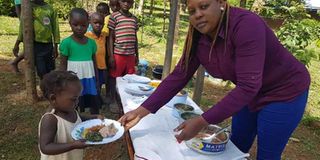Farmers in western urged to adopt horticulture to improve nutrition

Violet Wandera, a nutritionist, serves a sampling traditional vegetables meal to children in Busia. Farmers in the region, who mainly grow maize for sale, have been urged to embrace horticultural framing in order to improve their intake of varieties of healthy foods. PHOTO | RACHEL KIBUI | NATION MEDIA GROUP
What you need to know:
By feeding his family with own-farmed vegetables, Kubasu says he is able to save about Sh3,000.
On the other hand, he adds, he earns about Sh10,000 monthly from selling the vegetables.
- Irene Musumba says farmers should shift from the farming as a culture, and instead embrace agribusiness.
It is during a morning drive around Kanjala Village in Butula, Busia County.
Farms are full of a healthy green maize crop, perfectly ready for roasting or boiling, but definitely not ready for harvesting.
Seemingly, like in most parts of the country, maize is not only a common crop here, but maize meal is the staple food.
At the heart of this village is Zachayo Kubasu’s 0.25 acre farm.
He has decided to beat all odds and engage in horticulture, a venture which he considers more lucrative than the usual maize farming.
Kubasu, 32, is a traditional vegetables farmer who grows a variety of green vegetables such as night shade, amaranth and pumpkin leaves among others.
“I farm vegetables to not only improve nutrition for my family and my clients’ families but also to earn better, quicker money,” says the father of three.

Loaded with nutrients: A sample of a meal comprising traditional vegetables grown in western Kenya. PHOTO | RACHEL KIBUI | NATION MEDIA GROUP
VEGETABLES
By feeding his family with own-farmed vegetables, Kubasu says he is able to save about Sh3,000.
On the other hand, he adds, he earns about Sh10,000 monthly from selling the vegetables.
Was he to farm maize in the same piece of land, he would anticipate to harvest about 25 kilograms of maize, worth about Sh500.
“But I took advantage of my well in the homestead and decided to venture into vegetable farming thus increasing my income,” says Kubasu
Initially, he specialised in growing collard green vegetables. However, he discovered that they were costly to produce as they required frequent use of pesticides and were prone to many pests and diseases.
Further, he received training from USAID through the Kenya Agricultural Value Chain Enterprises (Kaves) project.

Zachayos Kubasu attends to his vegetables farm in Busia County. He has decided to beat all odds and engage in horticulture in an area where most people grow maize. PHOTO | RACHEL KIBUI | NATION MEDIA GROUP
AGRICULTURE VALUE CHAIN
Kaves aimed at improving various sectors in the agricultural value chain including dairy, horticulture, agri-nutrition and staples. The five-year project closed out in December 2017, having been successfully implemented in 22 counties across the country.
According to experts, smallholder farmers should embrace high-value crops to maximize on income, as opposed to clinging to traditional maize and other cereals.
Irene Musumba, a horticulturalist who worked with Kaves says farmers should shift from the farming as a culture, and instead embrace agribusiness as a viable source of employment and income.
Such farmers, Irene adds, can still spend the income from horticultural crops in purchasing food such as maize and beans which are often produced by more people.
Besides vegetables, other high value crops, according to Irene, include bananas, sweet potatoes, and tomatoes, among others.
According to nutritionists, traditional vegetables are rich in nutrients such as vitamins, zinc and iron.
Violet Wandera, a Busia-based nutritionist says the vegetables are therefore very important especially for children, expectant and lactating mothers.
AGRI-NUTRITION
While most farmers focus on food security and income generation, Violet notes, agri-nutrition should be key for a healthy society.
In a bid to encourage people to embrace this kind of farming, Kaves often organised sensitisation forums for local communities.
The forums exposed participants to various ways of preparing traditional vegetables and the need to increase acreage under horticultural farming as opposed to being over-reliant on production of cereals.
Climate change, characterised by prolonged dry spells and infestation by pests are among the many challenges that affect maize crops in many parts of the country.
This has further pushed many farmers into diversifying their farming from mainly maize, to dairy, horticulture and other ventures.





